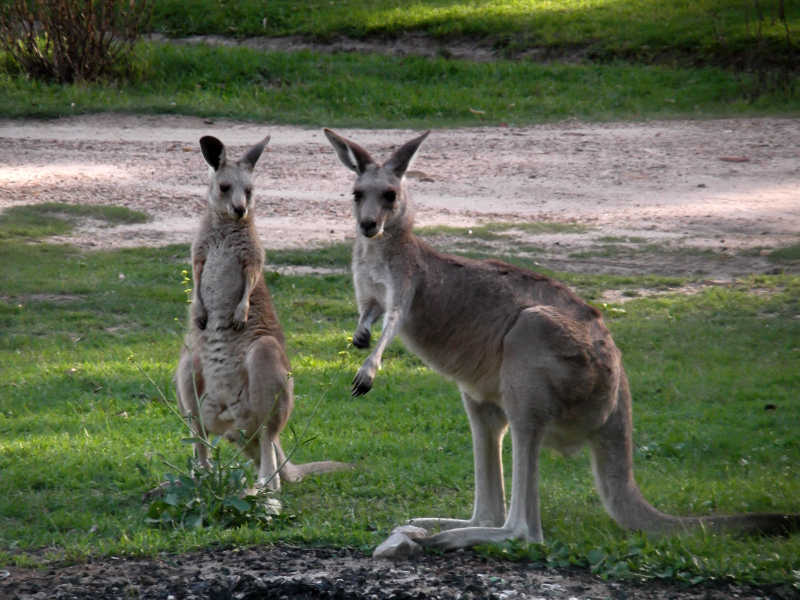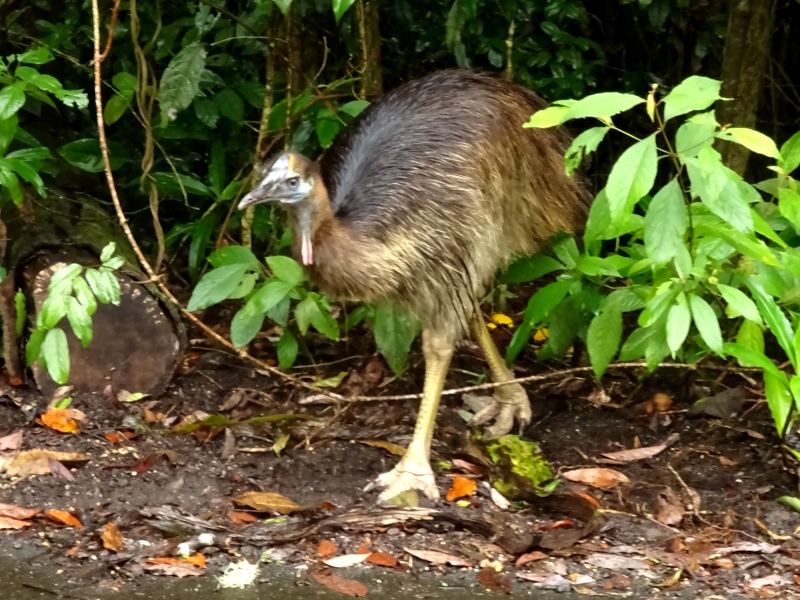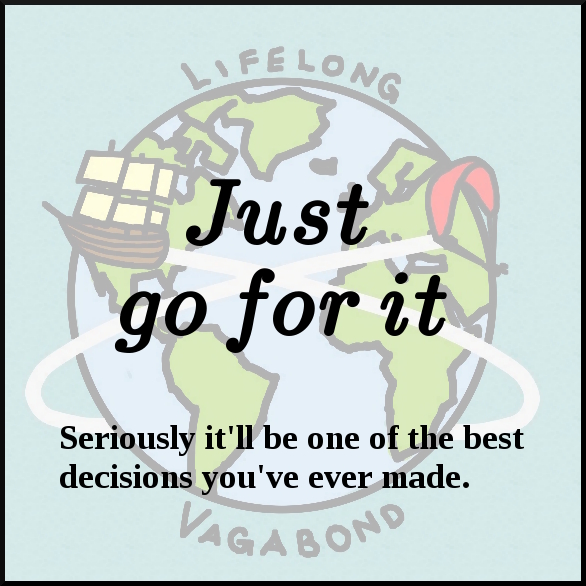10 Easy Places to Spot Australian Animals in the Wild
01 April 2016 | Mri Grout
The best times to view Australia's wildlife is at sunset and sunrise due to the harsh heat of the Australian sun. However, that doesn't mean they never come out at any other time, like when it's cloudy, so pop in to the places below and see what you can see!
1. Kangaroos Pretty Much Everywhere in Australia
The only national animal that is considered a pest and thus, actively hunted can easily be found pretty much anywhere outside of Australia's major cities. Because of this abundance of territory, I have decided to tell you about my two favourite kangaroo hot spots (in no particular order).
 1. First up, is a free campsite about 34km north of Lithgow, NSW located here. It's situated in the middle of a stunning canyon that is also home to multiple different mobs of roos. They roam the grounds freely and in the three nights we were there, we must have seen over fifty of them. To top this place all off, there are a handful of drop toilets and a single fresh-water stream just itching to be played in (the stream, not the loos :P)
1. First up, is a free campsite about 34km north of Lithgow, NSW located here. It's situated in the middle of a stunning canyon that is also home to multiple different mobs of roos. They roam the grounds freely and in the three nights we were there, we must have seen over fifty of them. To top this place all off, there are a handful of drop toilets and a single fresh-water stream just itching to be played in (the stream, not the loos :P)
2. Now Pebbly Beach is bit harder to get to (for free unless you want to risk getting a ticket) as it requires a bit of a walk from the nearest free parking spot. Though once you get here, you are pretty much guaranteed to see wallabies (a smaller type of roo) within spitting distance and if you're brave enough to edge a little closer, they don't seem to mind. There's a sign there saying don't feed them as it makes them very aggressive and they can seriously hurt each other, so please take heed. However, if you just pretend to throw out food (or hold out a tasty bit of grass) they'll come right up to you. (:
2. Koalas on the Great Ocean Road, Victoria
Due to their diet being ridiculously low in energy, koalas are slow moving creatures that sleep for 16-18 hours a day. A common way for them to die is via dogs (they're absolutely useless on the ground), so make sure you keep your pets on a leash when out looking for them at dusk. The coastline between Apollo Bay and Lorne is supposedly the best place to spot koalas, but though I have woken up ten feet underneath one near Apollo Bay, they're kind of a hit and miss if you go at any other hour than dusk or dawn. Two other likely destinations are Grey River Road and along Kennet River, but I've never seen any at either.Traveler's Tip: When driving along, don't look up in the trees - just look out for the groups of tourists pulled crazily over on the side of the road and pointing upwards. :P
3. Emus at Tower Hill Nature Resort, Victoria
Emus are yet another animal easily seen on the coastline of Victoria. Just to the west of the Great Ocean Road is a nature resort called Tower Hill that is home to a family of emus that hang around the picnic area. Sometimes they will approach you for food (though don't feed them as aggressive emus are deadly with their dinosaur talons), but for the most part they simply ignore all of your oohs and ahhs as they continue pecking at the ground.
4. Crocodiles Lounging at Windjana Gorge, West Australia
What Australian animal list would be complete without the much feared crocodile? Though, in actuality, these giant reptiles are responsible for less than one death a year in the great Land Down Under; different statistics for the Nile. Now I've never been to Windjana Gorge myself, but many say it's a guaranteed spot to see a freshwater crocodile (you know, the normally harmless types) and even better, it's easily accessible by car (though Aussie's definition of 'easily accessible' needs to be taken with a grain of salt).For those of you on the east cost, unless you have access to a free boat you're probably not going to see them in the wild for free...well, unless you're suicidal and care for a little swim. Though FUN FACT: The saltwater crocs that are big enough to eat you actually only eat maybe once or twice a year so take that as you will. lols.
5. Sharks Swimming at the Bottom of Cabbage Tree Bay, New South Wales
Now, I'm not covering the Great Whites that are so iconic to Australia due to the average traveler being unable to get in the water with them without paying for a cage, but the ones I am covering are the smaller sharks like the Port Jackson (average of 75-85 cm or 2'6”), Wobbegongs (avg of 1.25m or 4'), and Dusky Whaler Sharks (average of 4.2m or 14') - aka: sharks you can swim with without a cage/for free. These three (along with gorgeously spotted and striped rays, curious blue gropers, and many other fish) are easily found when swimming in the sheltered waters of Cabbage Tree Bay Aquatic Reserve - especially along the rocks that connects the two beaches. These sharks swim at around 12 metres, so are still easily viewable with just snorkeling gear.The best time to snorkel/dive this reserve for seeing sharks is from January to July when the Dusky Whaler Shark uses this bay as a nursery.
6. Cassowary at Hypipimee Crater, Queensland
 Despite our three day look-out for them, we only saw one and its head wasn't even blue. We only recognized it as a cassowary because of its wattle (ie: chin thingy), which meant it must have been an adolescent as the chicks are striped and fathers and daughters stay together – for a longer time at least. The place we saw this little guy was at Hypipimee Crater, though according to the internet Etty Bay and Mission Beach are supposed to have a high chance of viewings. We didn't see any at either of those though, which just goes to show that you have to have a bit more patience when on the look-out for the amazing cassowary.
Despite our three day look-out for them, we only saw one and its head wasn't even blue. We only recognized it as a cassowary because of its wattle (ie: chin thingy), which meant it must have been an adolescent as the chicks are striped and fathers and daughters stay together – for a longer time at least. The place we saw this little guy was at Hypipimee Crater, though according to the internet Etty Bay and Mission Beach are supposed to have a high chance of viewings. We didn't see any at either of those though, which just goes to show that you have to have a bit more patience when on the look-out for the amazing cassowary.
7. Platypus Spotting at Broken River
The more famous of the only two mammals that lay eggs, the platypus can easily be found at Broken River, Eugella National Park. They can hold their breath for up to twenty minutes at a time, so you might need a bit of patience and a keen eye to spot them, though I'd be surprised if you don't see at least one here. The river is also home to kingfishers, plenty of turtles, and a pretty green ladybug-like creature. You're not allowed to camp here, but though the best times to see them are at dusk and dawn like everything else, we saw many out and about at 15.00 – it was a cloudy day though so not as hot as normal.
8. Pelican Feeding at The Entrance, New South Wales
Every day at 15.00 there is a pelican feeding at The Entrance, NSW. It last about 15 - 30 minutes so you don't want to be too late. They are all wild so don't try to pet them as they will bite. They simply come in (somehow being fantastic tellers of time) for the leftover fish at the local fish and chip shop. The man who feeds them knows his facts and how to be entertaining so it's definitely worth a visit. (: Though if you do miss it, then don't fret. If you're spending any sort of time near the Australian coast, you'll see a pelican for sure.
9. Seals Frolicking at Cape Bridgewater, Victoria
Home to Australia's only mainland seal colony, Cape Bridgewater is a must see. There is an estimated 650 seals that call this place home, including pups and adolescents learning how to swim. So make sure to take your binoculars and simply enjoy the frolicking of the seals below you as they surf and play in the waves. Then carry on the walk and marvel at the petrified forest, windmill farms, and blowholes.
10. Blue Penguins at Phillip's Island, Victoria
 Due to some asshat jerks thinking it'd be fun to see how many penguins they could run over in a single night, Phillip's Island is now closed to everyone except for tour companies from one hour before dusk to an hour after dawn. Obviously, that's the best time to see them, but if you're patient and watch the burrows (yes, penguins make burrows! How cool is that?), you could see these awesome blue waddlers for free. I would also check under the boardwalk during chick season, but even if you don't see them here the views overlooking the ocean are still worth the bother...especially if you have a pair of binoculars you can focus on the rock situated right off the coast. (:
Due to some asshat jerks thinking it'd be fun to see how many penguins they could run over in a single night, Phillip's Island is now closed to everyone except for tour companies from one hour before dusk to an hour after dawn. Obviously, that's the best time to see them, but if you're patient and watch the burrows (yes, penguins make burrows! How cool is that?), you could see these awesome blue waddlers for free. I would also check under the boardwalk during chick season, but even if you don't see them here the views overlooking the ocean are still worth the bother...especially if you have a pair of binoculars you can focus on the rock situated right off the coast. (:

Travel Tip #4

Do you know of any other free places to see Australian wildlife? Or just want to write a review on one of the above places you've been? Then we'd love to hear all about them in the comments below!




